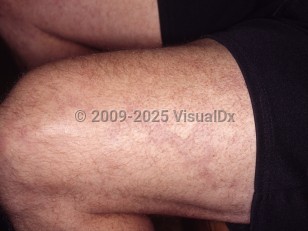Sneddon syndrome predominantly occurs in young women, and the first cerebral ischemic event is usually before the age of 45. The key cutaneous feature is a persistent livedo reticularis, often in a livedo racemosa pattern (form of livedo reticularis consisting of a large branching pattern, usually on the trunk, limbs, and proximal extremities).
Many individuals with Sneddon syndrome have antiphospholipid antibodies. The prevalence has been reported to be from 0% to 85%. Regardless of whether patients have antiphospholipid antibodies, individuals with Sneddon syndrome have identical occlusive arteriopathy and endothelial damage. Up to 35% will have antiendothelial cell antibodies.
Clinical features:
- Livedo racemosa – often precedes the onset of focal neurologic symptoms.
- Headache and vertigo – most frequent symptoms; may precede livedo racemosa by several years, but are nonspecific.
- Ischemic strokes – most symptoms are from middle cerebral artery infarcts: hemiparesis, sensory alterations, and aphasia. Less commonly, there may be dysarthria, visual field deficits, or sudden spontaneous falls.
- Transient ischemic attacks
- Vascular dementia
- Secondary symptoms and other organ manifestations include arterial hypertension (65%), valvulopathy (61%), ischemic heart disease, ocular symptoms, renal involvement (50% to 70%), gastrointestinal symptoms, recurrent deep vein thrombosis, and fetal loss.



